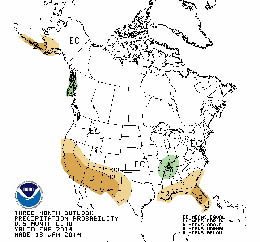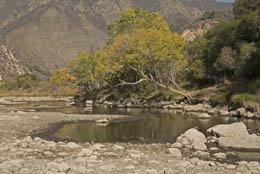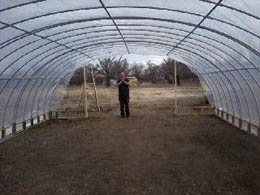California’s Bitter Drought
- By Pia Hinckle
- Reading Time: 5 mins.
 Image courtesy of NOAA
Image courtesy of NOAA
California Governor Jerry Brown declared on January 17, 2014, what farmers and ranchers have known for some time — the state is in a drought, possibly the worst one in living memory. Farmers, ranchers, wildlife, and consumers are all likely to be impacted by a third year of so far record low precipitation.
Farmers are planning to drop water-intensive crops like corn and maybe even tomatoes, while spending money on well-pumping and extending drip irrigation systems; cattle ranchers are culling their herds for both lack of water and pasture — fields are as dry and brown as they were in August instead of a lush, verdant wintergreen — with costs mounting for feed and water.
“We are making some changes for next year, dropping high water-use crops like corn,” said Jenna Muller of Full Belly Farm, a 350-acre certified organic farm in Yolo County that grows fruits, vegetables, nuts, herbs, and flowers year-round. “It’s also possible that later plantings of tomatoes won’t be planted if we don’t get rain.” Jenna told The FruitGuys Almanac that the farm should be okay for this year, even if the drought continues, but “if next year is a drought too, that will be an even bigger problem.” She added that they were having trouble finding pasture for their sheep and having to buy a lot of hay to replace it.
California farms grow nearly half of the fruits, vegetables, and nuts sold in the United States. Continued drought could cause price increases for produce, dairy products, beef, and nuts as production costs increase to make up for lack of water and pasture.
Want farm-fresh fruit?
We've got you covered.Why No Rain?
 Image courtesy of NOAA
Image courtesy of NOAA
An unusually large and persistent high-pressure ridge over the Western states is diverting the jet stream and blocking the usual winter storm pattern that brings rain to California. Meteorologists and climatologists are unsure why it has formed or when it will go away.
Rivers, creeks, and reservoirs are already low and the Sierra Nevada snowpack, the source of the bulk of the state’s water, was at only 17 percent of normal at the end of January. California gets about half of its annual rainfall between December and February, according to the State Department of Water Resources. On the heels of two dry years, even “a normal precipitation year would not be enough to overcome low soil moisture and water storage conditions; many water users would need a wet year to be made whole,” the agency website reported. And the current forecast shows below normal rainfall, if any, through April.
Water Wars
 Agriculture isn’t the only user of water in California; the state’s population has nearly doubled, to 38 million residents, since the last prolonged drought in the late 1970s. Gov. Brown called for a voluntary water-use reduction of 20 percent for residents, businesses, and government agencies. For starters, citizens are advised to use brooms instead of hoses to clean driveways, reduce shower time, install low-flow showers, toilets, and sinks, run only full dishwashers and clothes washers, and limit watering of gardens and washing cars. Aquafornia, a water education foundation, has a list of indoor and outdoor water-saving tips for residents.
Agriculture isn’t the only user of water in California; the state’s population has nearly doubled, to 38 million residents, since the last prolonged drought in the late 1970s. Gov. Brown called for a voluntary water-use reduction of 20 percent for residents, businesses, and government agencies. For starters, citizens are advised to use brooms instead of hoses to clean driveways, reduce shower time, install low-flow showers, toilets, and sinks, run only full dishwashers and clothes washers, and limit watering of gardens and washing cars. Aquafornia, a water education foundation, has a list of indoor and outdoor water-saving tips for residents.
Want farm-fresh fruit?
We've got you covered.
 County, state, and federal authorities are devising emergency drought plans. Sonoma and Marin counties, just north of San Francisco, which depend on local rivers and groundwater supplies, have already introduced some mandatory rationing. Speaker of the House John Boehner (R- OH) visited the Central Valley Jan. 19 to meet local representatives and farmers to discuss federal help including legislation to increase water allotments to agriculture and putting on hold an embattled restoration project for the San Joaquin River meant to protect salmon-spawning areas in the North. Farmers, developers, and environmentalists have been in a pitched battle for years over water allotment — just how much northern river water is captured for water reclamation and farming use in the Central Valley and southern California, and how much goes “free” to rivers and streams for habitat restoration.
County, state, and federal authorities are devising emergency drought plans. Sonoma and Marin counties, just north of San Francisco, which depend on local rivers and groundwater supplies, have already introduced some mandatory rationing. Speaker of the House John Boehner (R- OH) visited the Central Valley Jan. 19 to meet local representatives and farmers to discuss federal help including legislation to increase water allotments to agriculture and putting on hold an embattled restoration project for the San Joaquin River meant to protect salmon-spawning areas in the North. Farmers, developers, and environmentalists have been in a pitched battle for years over water allotment — just how much northern river water is captured for water reclamation and farming use in the Central Valley and southern California, and how much goes “free” to rivers and streams for habitat restoration.
Wildlife is also being affected. The risk for wildfires is extreme; native salmon are having trouble finding places to spawn because water levels in rivers and streams are so low; some bears in the high Sierra have come out of hibernation early and surprised skiers and hikers.
Farm Choices
 Hoop House
Hoop HouseImage courtesy of Red Heart Ranch, Finley CA
In January, many California farms are preparing for the growing season and making choices about what will be planted and what to do now. The drought means that more farms are also expanding water-saving practices, such as drip irrigation, hoop houses, misters, and solar water pumps — if they can afford it. Young trees and perennials need to be watered through the winter to get their roots well established.
“We’ve been using drip irrigation with some sprinkling and traditional flood irrigation. We will be switching over to full drip this season to conserve water,” John Moorhead of Red Heart Ranch in Lake County told the Almanac. “We will probably plant fewer high water-use crops such as corn — a shame because I really love corn, but the drip set up is really a game-changer for us. We are putting in an entire section of raised beds this year. Raised beds are more productive and use less water. Using raised beds, drip irrigation, and having the hoop house, we hope, will mitigate the additional challenges of drought water conditions and more intense heat this summer.”
 Solar Water Pump
Solar Water PumpImage courtesy of Red Heart Ranch, Finley CA
Moorhead got a head start in conservation during last year’s dry spell by installing a solar-powered water pump in an existing well and a new water storage tank and hoop house. “The demand for water pumping coincides with the demand for air conditioning. Should there be brownouts this summer, and I suspect there will be, we will be able to irrigate independently with zero demand on the utility grid,” he said. “The settling action of having a storage tank really helps with sediment, so we have cleaner water and much, much less trouble with clogged and fouled drip system components. We also have greater water pressure, so our ability to expand our drip system is enhanced.” Moorhead credited a $5,000 grant from The FruitGuys Community Fund with getting the project done. “Thanks to the Community Fund, our ability to conserve and carefully distribute water is much improved.”
Moorhead said he was still concerned for well water levels because his neighbors on either side draw from the same aquifer and are growing grapes and walnuts, both water-intensive crops. “Their grapes and walnuts are still sprinkler irrigated — very inefficient,” he added. “Their water use is likely to have a greater impact on aquifer water levels than our own. After checking out the system that we were able to install, our ”˜walnut’ neighbor is very interested in converting to solar/drip and may well be applying for an irrigation grant from the Community Fund!”
The FruitGuys Community Fund, a non-profit fiscally sponsored project of Community Initiatives, is still accepting applications for grants for small farm sustainability projects for its 2014 funding cycle.


